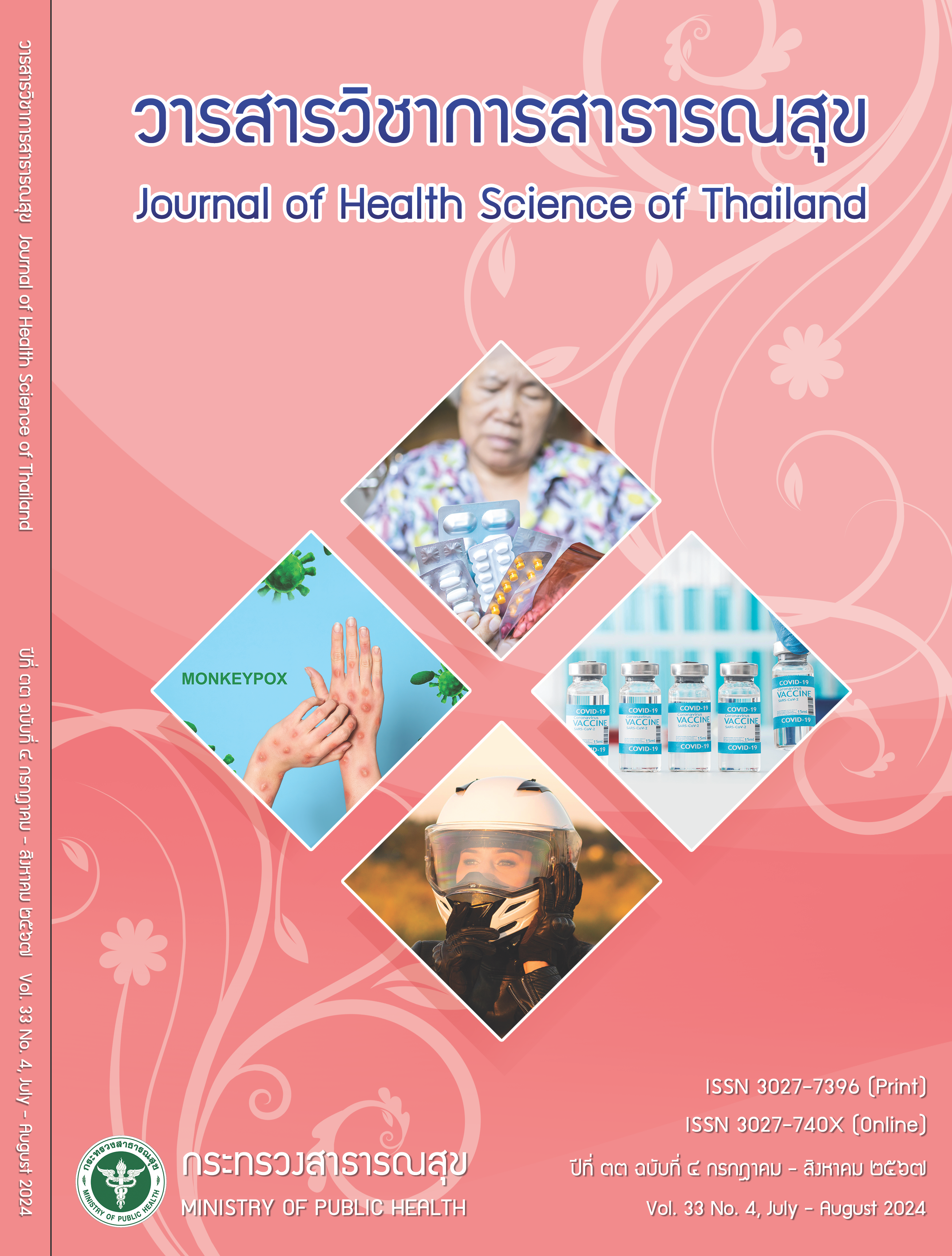Effect of a Telemedicine Intervention on a Social Skills Training Program in Children with Autism Spectrum Disorder
Keywords:
social skill training program, occupational therapist, telemedicine, autistic, caregiverAbstract
This mixed methods research study aimed to investigate the effects of remote social skills training in children with autism. The quantitative research procedure was a quasi-experimental study with a pretest-posttest control group design. The sample consisted of 30 autistic children aged 7-12 years. They were divided into an experimental group and a control group of 15 participants each. The control group received traditional social skills training by occupational therapists. The experimental group received a remote social skills program delivered by a caregiver, with video recording and tracking via the LINE application over 10 weeks. After completion of the program, in-depth interviews were conducted with 15 caregivers who had used the remote social skills program. Quantitative data were analyzed using descriptive statistics, chi-square tests, paired t-tests, and independent t-tests. The qualitative data was analyzed using content analysis. The results of the study show that the autistic children in the remote social skills training group showed a statistically significant increase in their mean social skills scores after the experiment (p=0.00), similar to the traditional social skills training. The mean social skills scores between the two groups were not different before and after the experiment. The results of the in-depth interviews show that there are four main themes related to the telemedicine intervention for the social skills training program: (1) building relationships and new learning, (2) convenience, reducing costs, time and travel, (3) application in daily life, and (4) choice of treatment, demonstrating that a program can be used as a guide for autistic children’s development, encourage family involvement as an alternative for service delivery, and be offered in two ways simultaneously.
Downloads
References
Centers for Disease Control and Preventio. Basics about autism spectrum disorder (ASD) [Internet]. 2022 [cited 2022 Apr 24]. Available from: https://www.cdc.gov/ ncbddd/autism/facts.html
ทวีศักดิ์ สิริรัตน์เรขา. ออทิสติก [อินเทอร์์เน็ต]. [สืบค้นเมื่อ 25 เมษายน 2022]. แหล่งข้้อมููล: https://www.happy¬homeclinic.com/au02-autism.htm
นาถลดา ตะวันกาญจนโชติ. ทักษะทางสังคมของเด็ก ออทิสติกวัยเรียน. วารสารการพยาบาลจิตเวชและสุุขภาพจิิต 2559;30 (2):1–21.
ปณต โคตพัฒน์, มนัสวาสน์ โกวิทยา. ผลของการจัดกิจกรรมการศึกษานอกระบบโรงเรียนตามแนวคิดการศึกษาแบบใช้พื้นที่เป็นฐานเพื่อเสริมสร้างทักษะทางสังคมสำหรับบุคคลออทิสติกวัยรุ่น. วารสารอิเล็กทรอนิกส์ทางการศึกษา 2560;12(2):401–15.
Hotton M, Coles S. The effectiveness of social skills training groups for individuals with autismspectrum disorder. J Autism Dev Disord 2016;3 (1):68–81.
Olsson NC, Flygare O, Coco C, Görling A, Råde A, Chen Q, et al. Social skills training for children and adolescents with Autism Spectrum Disorder: A random¬ized controlled trial. J Am Acad Child Adolesc Psychi¬atry 2017;56(7):585–92.
Spain D, Blainey HS. Group social skills interventions for adults with high-functioning autismspectrum disor¬ders: a systematic review. Autism Int J Res Pract 2015; 19(7):874–86.
Deckers A, Muris P, Roelofs J, Arntz A. A group-ad¬ministered social skills training for 8-to 12-year-old, high-functioning children with Autism Spectrum Disor¬ders: an evaluation of its effectiveness in a naturalistic outpatient treatment setting. J Autism Dev Disord 2016; 46 (11):3493–504.
Krasny L, Williams BJ, Provencal S, Ozonoff S. Social skills interventions for the autism spectrum: essential ingredients and a model curriculum. Child Adolesc Psychiatr Clin N Am 2003;12 (1):107–22.
Mourad Ali Eissa Saad. A systemic review of autism spectrum disorder in children
and adolescents: social deficits and intervention. International Journal of Psycho - Educational Sciences 2017;6 (2):1-17
ธิรากร มณีรัตน์, พัชราภรณ์ เจนใจวิทย์, ภัทรา ฤชุวรารักษ์, ภัทราภรณ์ กาบกลาง, ปิยะวรรณ ศรีสุุรักษ์, พรมณี หาญหัก. การสร้างเสริมคุุณภาพชีวิตครอบครัวที่มีบุคคลออทิสติกในจังหวัดขอนแก่น ด้วยโปรแกรมฝึกทักษะสังคม. วารสารสำนักงานสาธารณสุขจังหวัดขอนแก่น 2563;2(1):107- 24.
เสาวลักษณ์ หมื่นเพชร, ฐิติมา องค์การธง. ผลของโปรแกรมการฝึกทักษะสังคมแบบกลุ่มในเด็กออทิสติก. วารสารวิชาการเขต 12 2559;27(3):75-9.
Liratni M, Blanchet C, Pry R. A longitudinal (3 years) study of the development of four children with autism without mental retardation after 90 sessions of social skills training. L’Encephale 2016;42(6):529–34.
มะลิวัลย์ เรือนคำ ,พรเพ็ญ ศิริสัตยะวงศ์, ศุภลักษณ์ เข็มทอง, วัฒนารีอัมมวรรธน์, พรทิพย์พา ธิพายอม. ผลกระทบจากการระบาดของโรคโควิด-19 ต่อการทำกิจกรรมการดำเนินชีวิตและรูปแบบการให้บริการทางกิจกรรมบำบัดที่่ตอบสนองต่อยุคชีวิตวิถีใหม่. นนทบุรี: สถาบันวิจัยระบบสาธารณสุุข; 2565
Kasai T. From the “new normal” to a “new future”: a sustainable response to COVID-19. Lancet Reg Health West Pac 2020;4:100043.
Eshraghi AA, Li C, Alessandri M, Messinger DS, Esh¬raghi RS, Mittal R, et al. COVID-19: overcoming the challenges faced by individuals with autism and their families. Lancet Psychiatry 2020;7(6):481–3.
Latzer IT, Leitner Y, Karnieli-Miller O. Core experi¬ences of parents of children with autismduring the COVID-19 pandemic lockdown. Autism Int J Res Pract 2021;25 (4):1047–59.
Baweja R, Brown S, Edwards E, Murray M. COVID-19 pandemic and impact on patients with autism spectrum disorder. J Autism Dev Disord 2022;52(1):473–82.
Wallisch A, Little L, Pope E, Dunn W. Parent perspec¬tives of an occupational therapy telehealth intervention. Int J Telerehabilitation 2019;11(1):15–22.
Cason J Telehealth. A rapidly developing service deliv¬ery model for occupational therapy. Int J Telerehabilita¬tion 2014;6 (1):29–35.
World Federation of Occupational Therapists. World Federation of Occupational Therapists’ position statement on telehealth. Int J Telerehabilitation 2014;6 (1):37–9.
Grant C, Jones A, Land H. What are the perspectives of speech pathologists, occupational therapists and physio¬therapists on using telehealth videoconferencing for service delivery to children with developmental delays? A systematic review of the literature. Aust J Rural Health 2022;30(3):321-36.
Hung G, Fong K. Effects of telerehabilitation in occu¬pational therapy practice: a systematic review. Hong Kong J Occup Ther HKJOT 2019;32(1):3–21.
Sarsak S. Telerehabilitation services: a successful para¬digm for occupational therapy clinicalservices? Int Phys Med Rehabil 2020;5(2):93–8.
Bruininks RH, Woodcock RW, Weatherman RF, Hill BK. Scales of independent behavior - revised. Itasca, IL: Riverside Publishing; 1996
Vismara AL, Mccormick C, Young SG, Nadhan A, Monlux K. Preliminary findings of a telehealth approach to parent training in Autism. J Autism Dev Disord 2013; 43(1):2953–69.
Camden C, Silva M. Pediatric telehealth: Opportunities created by the COVID-19 and suggestions to sustain Its use to support families of children with disabilities. Phys Occup Ther Pediatr 2021;41(1):1-17.
Pompa-Craven P, Tierman E, Martino J, Lotfizadeh AD. Caregiver satisfaction with delivery of telehealth Autism services. Adv Neurodev Disord 2022;6(2):196-205.
Downloads
Published
How to Cite
Issue
Section
License
Copyright (c) 2024 Ministry of Public Health

This work is licensed under a Creative Commons Attribution-NonCommercial-NoDerivatives 4.0 International License.







